
The cards must flow. Packs to feed the beast and a marketplace to sustain it, Artifact is a leviathan that demands tribute. While it is possible to tame the nightmare, I would never call this monstrosity a beloved pet, though not for the reasons you would expect. You might hear stories around the campfire of vagrants falling in love with the rich, complex gameplay or how the game feels like DotA. I, however, am the man sitting opposite that minstrel, donned in a black hoodie and scarred from my journeys with the very monster that this strangely wealthy traveller describes. The cards must flow, you see, and that’s what lured me into the clutches of Artifact in the first place.

The Good
Trying to explain the appeal of Artifact is almost as hard as describing the rules. You play on three boards (representing the three lanes in DotA) in any given game, each one housing a tower. The aim is to destroy two of your opponent’s towers or The Ancient which spawns where the first tower was destroyed. Your deck is composed of 5 heroes, a minimum of 40 coloured cards (15 coming from your heroes) and an additional set of 9 item cards. If a hero of a particular colour is in a lane, you can play cards of that colour or any items you want in that lane. The game plays back and forth like Gwent, heroes have abilities, cards can provide permanent modifications, two creeps spawn randomly into the three lanes each turn, blah blah blah, there’s a lot to take in. It’s a game that sounds way harder to play than it is, but you’ll have plenty of time to digest it.
The game does a magnificent job of pacing turns. Like Gwent, play only moves onto the next lane after both players pass their turn. You’ll have about 30 seconds after your opponent makes a move to react with your own, and that may sound long, but it’s almost perfect. You don’t end up waiting on the rope like in Hearthstone, and the back and forth turns foster an excellent sense of tension. Passing your turn is a viable tactic to see if your opponent feels like making a move or not, but it’s a huge risk if he kills your hero because you neglected to heal them. Games are tight, and each card feels like it holds weight, which I can say with certainty thanks to the UI.
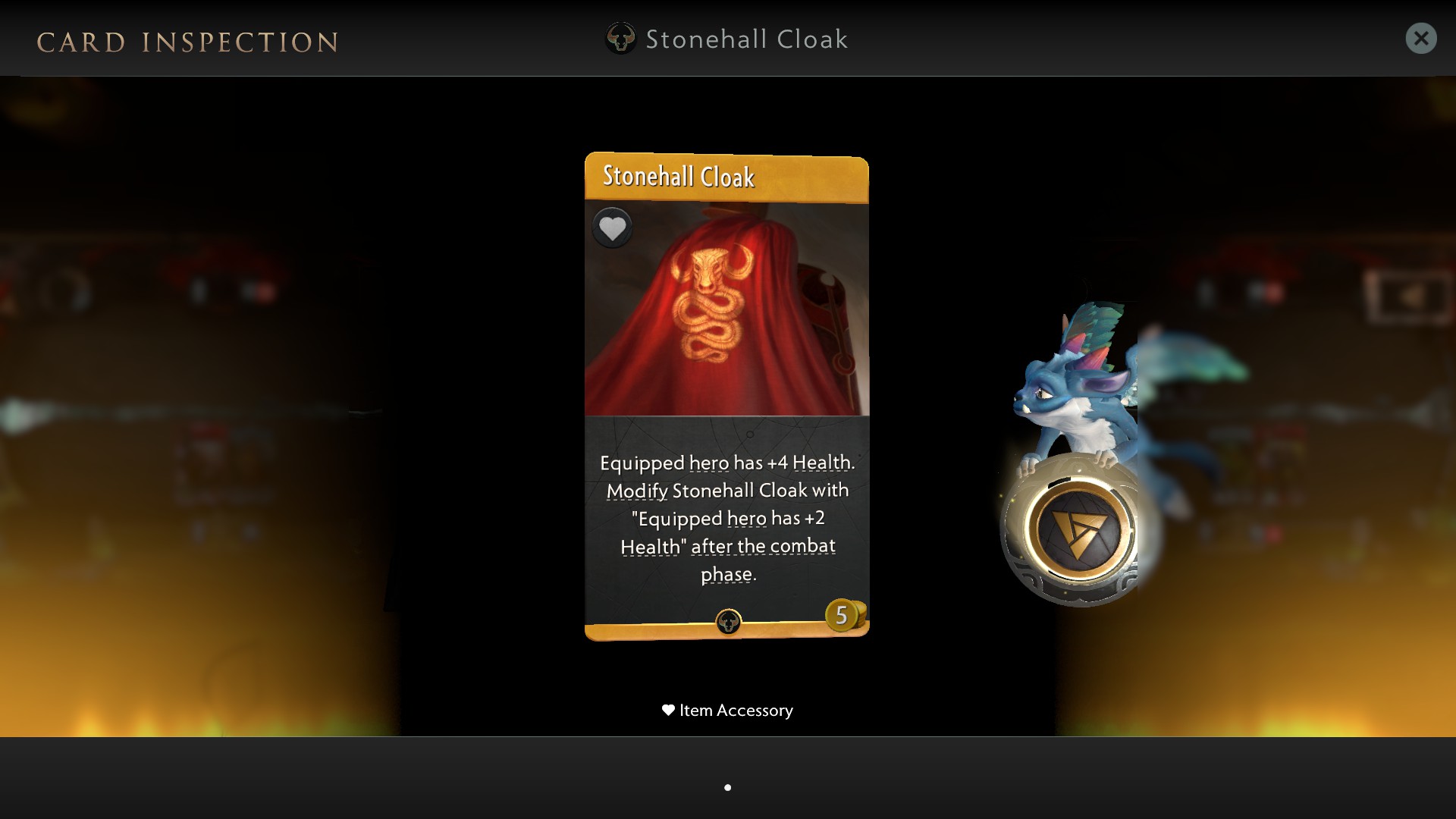
Perhaps the best part of Artifact is its dedication to clarity. If you double-click any card, it will bring up a zoomed-in version for you to check all its keywords and stats, perfect if you’re just starting. You don’t need to worry about mental maths because the game previews all damage done, so you’ll know exactly how things will pan out when you move to the next lane. You can even hover over the health or attack stat of a unit on the board to get a full breakdown of why their stats are that high. Keeping track of the numbers for you is a real lifesaver, because a lot of the game revolves around improving what you’re working with.
An active element of the game is improvements, a clear parallel to DotA’s gameplay. You can buy equipment from the shop, use cards to boost stats or summon creeps that improve over time. When people say the game feels like DotA, the ramp is mostly why, and it feels great when it goes your way. As time goes on, all your units become better and better until they become an unstoppable, unkillable and unbelievable force of destruction. The same is true of your opponent, so you end up with tight, exhilarating matches that keep you coming back for more, and then there’s making a deck.
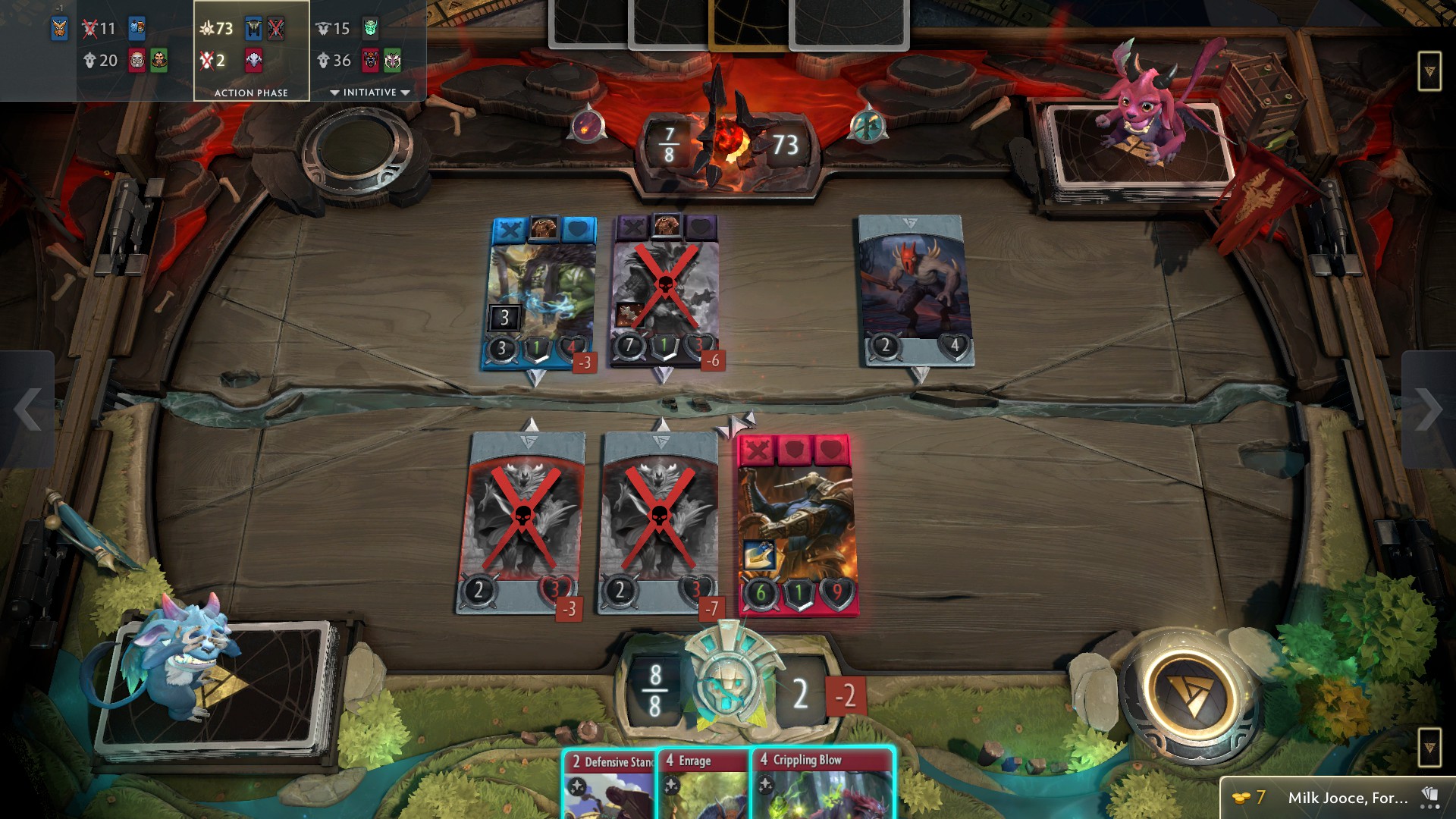
While there’s not much card variety yet, making a deck in Artifact is a fascinating process. When you pick a hero, three of that hero’s signature card go into your deck, which means that your hero makeup more or less determines the deck’s play-style. There are four colours (Red, Blue, Green and Black), each favouring a particular style of play, but there are twelve heroes of each colour. Mixing and matching heroes is a fun process, and the deckbuilding menu does a great job of highlighting the critical information you’ll want to know. I won’t say that the game has a stellar number of cards, but it certainly has enough to keep you thinking about synergies and combos. Then, when your deck is finally ready, you can watch RNG completely flatten it.
The Bad
While the game offers a lot to dig into, it’s undermined by an absurd amount of RNG. You can’t control the placement of creeps, even if you’re screaming at the screen at where the most blatantly obvious placement would be. You can’t control whether your unblocked units will attack the tower or a neighbouring unit, which can turn your 17 attack beast into a useless bystander for a turn. Cards like Cheating Death can turn the tide of the game based on a coin flip, and Homefield Advantage can pick a useless creep as readily as a hero. What appears in the shop is random too, so while your item deck can be filled with low-cost options, you don’t have the reliability of basic consumables on offer. Oh, but I can already hear the fanbase screaming, “There are cards to mitigate it! That’s the point of the game! It’s what keeps it interesting!” and that is the crux of the issue.
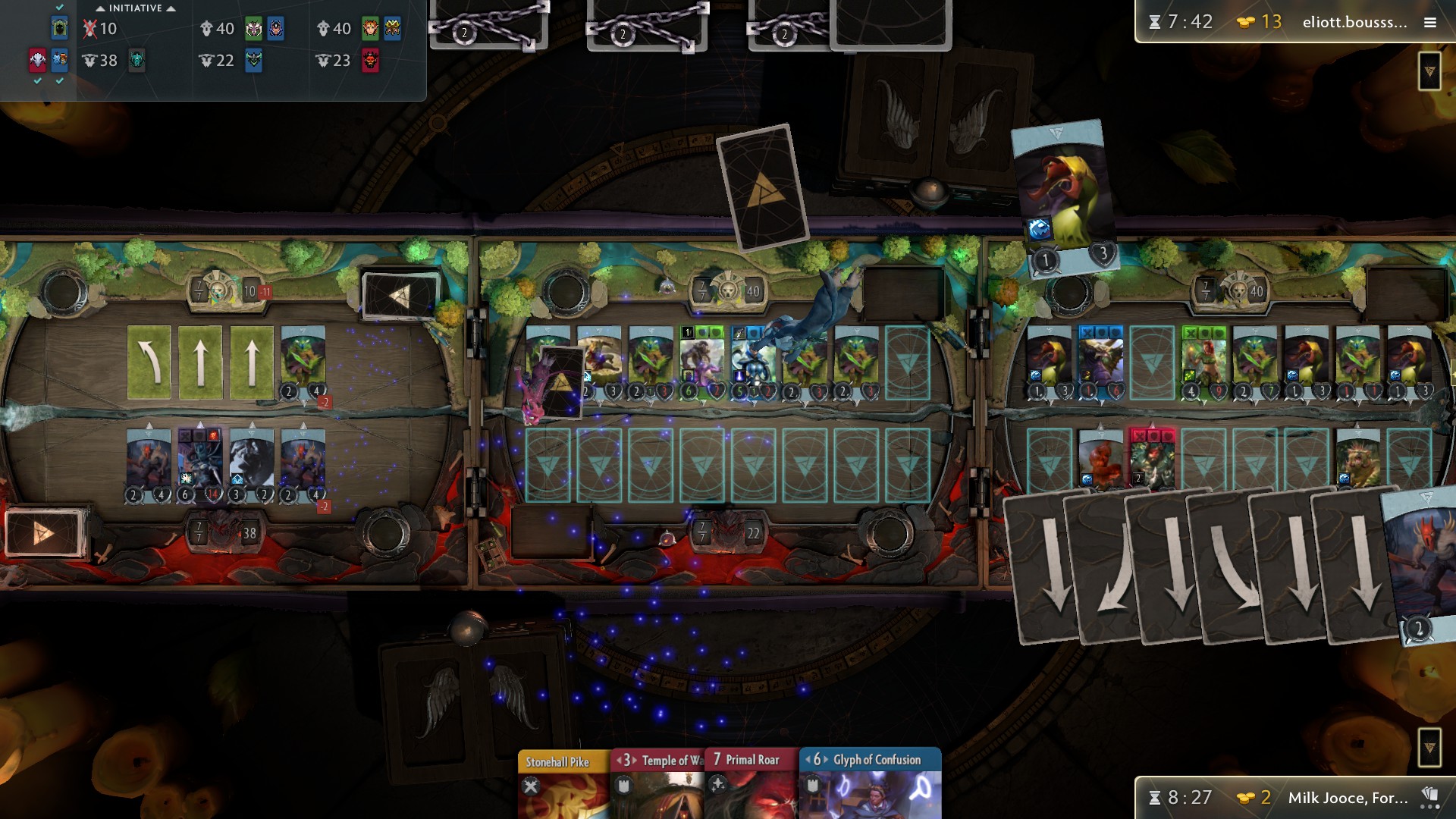
More often than not, it felt like I was fighting RNG more than my opponent. Plenty of cards play with absolute certainty, but fundamental things like creep spawns and combat directions are entirely outside my control. Regardless of my opponent’s skill or cunning, I’d end up in situations where units decided winning was secondary to clearing the board. Some cards can mitigate the randomness, allowing you to change combat targets or kill off units, but you can only do so much to turn the odds in your favour. Whenever I won, it felt like luck. Whenever I lost, it felt like luck. Working the randomness in your favour is a crucial element of the game, but the RNG inherent in the design was more frustrating to deal with than rewarding to overcome. I understand that TCG’s have variance and randomness in them, but so much of Artifact’s RNG is out of my hands that I don’t know if I want to keep playing. I enjoy the game, but it’s frustrating to engage with, and the same can be said of the UX.
While the interface is crisper than burnt toast, there’s plenty the game lacks to make it feel alive. While the board looks gorgeous, you can’t interact with it or the imps in any way, so it doesn’t feel physical in the same way Hearthstone did. The turn timer warnings are also non-diegetic, so they get the job done but break the atmosphere of the game. You can’t interact with your opponent through taunts or emotes, so it doesn’t feel like anyone’s on the other end of those cards. There are no leaderboards, no profiles to see your game statistics, practically nothing outside the core game. These are basic features that audiences expect, including me, and the game feels barren and lonely without them. There’s very little to keep you coming back, which is made worse by the lack of progression in the game.
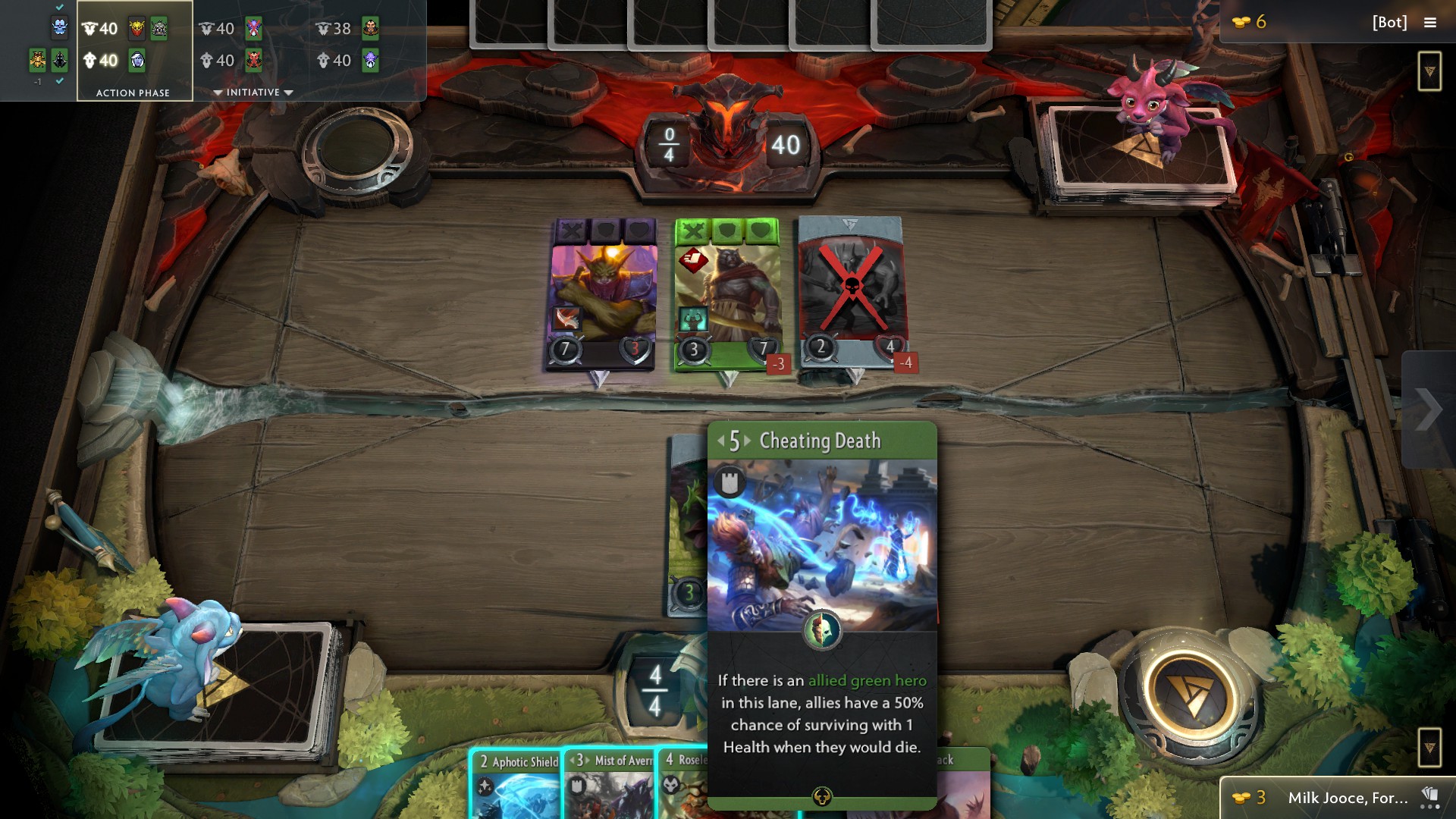
While I’ll expand my thoughts on the monetisation soon, let’s talk about the progression system in the game. There are no leaderboards, no level/XP system, no cards earned for playing (ish) and no real incentive to play outside of the card game itself. You can earn packs and event tickets in the competitive modes, but not the casual ones, and that’s only assuming you win enough matches to receive them. For some, that might be enough, but without a way to earn cards casually, even if they can only be used in casual modes, I’m struggling to justify putting more time in. I’m stuck with the same cards, the same decks and the same old games because I can’t construct a competitive deck, and drafts rely on, yet again, RNG. Drafts aren’t hard to game if you’re picking the broken cards, though, which are plentiful.
The game has a lot of balance issues right now that are exacerbated by the RNG inherent in the game’s design. Cheating Death means a coin flip to deny five gold while still doing full damage to the enemy unit, leaving the potential to heal the hero back to full health. It’s a card that doesn’t reward cunning plays, works against cards like Annihilation and is the epitome of RNG nonsense. How the hell did this get through a beta let alone reach full release?! Heroes aren’t immune from the scorn of RNG either. You can lose a hero in turn one because you were unlucky enough to spawn opposite Axe instead of the creep right next to him. The worst part is that the game feels like DotA since the rich get richer, but it doesn’t add to the fun.

There are unbalanced cards and heroes, sure, but if you can get the ball rolling, the rest of the game is practically a formality. There are plenty of items and creeps that improve over time, so if someone’s winning, it’ll keep getting harder and harder for the other player to claw back a win. The unforgiving ramp of DotA is in full swing here, and while plenty of people will love it, it’s undermined by the RNG putting a creep in the way. Because of the sheer amount of stuff that’s out of your hands, you can’t meaningfully turn the tides without a great deal of luck. Frustratingly enough, that’s what makes the game interesting in the first place. Without the RNG there, the rich getting richer problem would be much, much worse, so… I don’t know, buy cards that subvert the RNG? Oooohhh boy, here we go.
The Monetisation
I’m not a rich man, some might even call me unemployed, so having to buy Artifact upfront wasn’t the most appealing decision in the world. The $27.95 price tag seemed odd to me at first, but it all made perfect sense once I was in the game. You start with two decks that are used in the tutorial and given ten packs to open (costing $2.65 each). You’re paying for ten packs, two starter decks and access to the client. Makes perfect sense. You have to buy-in to play the game, and then you don’t even get to pick your starting deck, so you’re stuck with a random assortment of cards to play with. Genius, but we’re not even into the good bits yet.
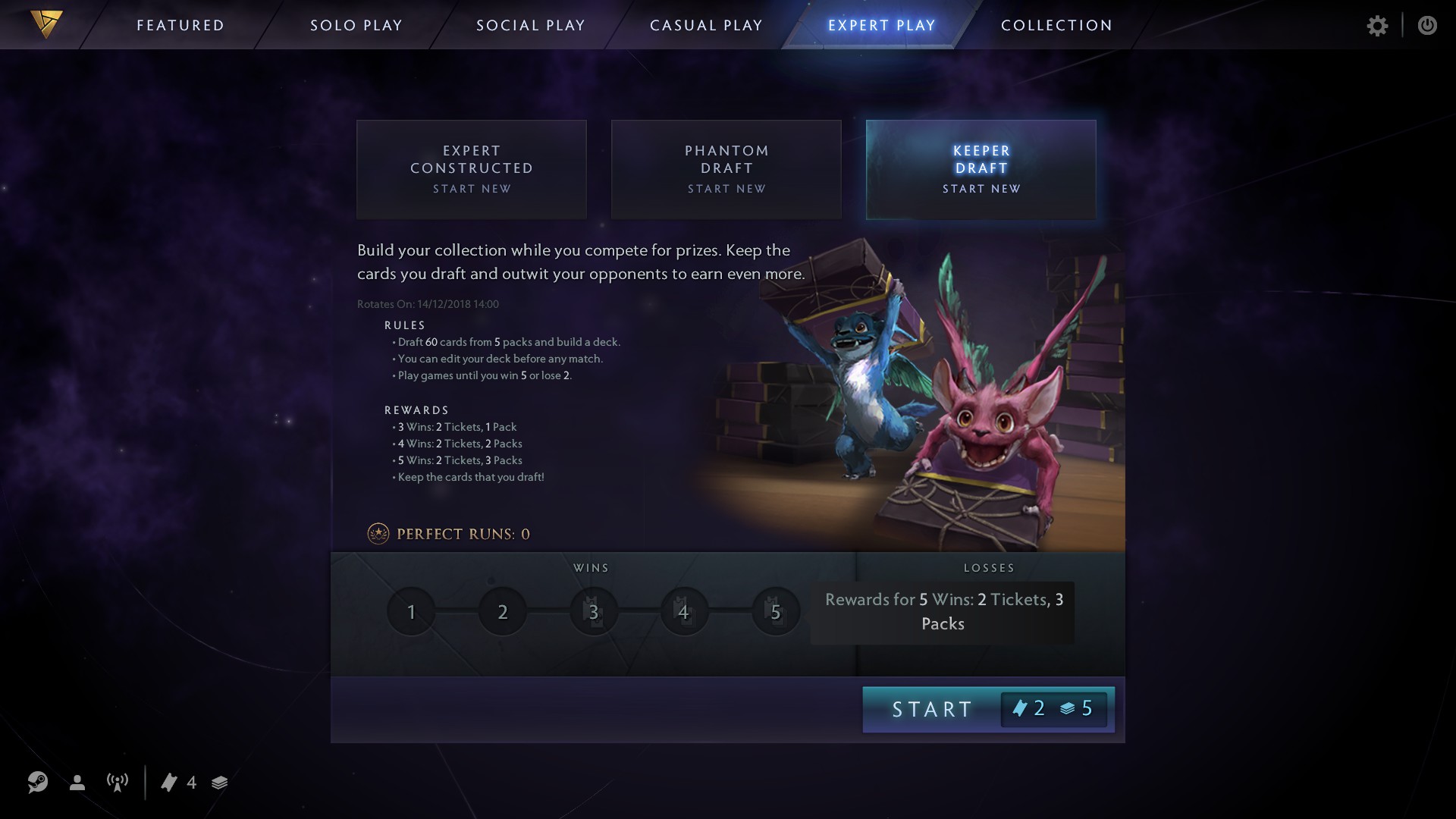
I mentioned before that there’s no way to earn cards from playing casually. The only way to earn more cards is to play a ‘gauntlet’ in the competitive modes, either by drafting or constructing a deck and playing up to six games. To play in these modes, you require event tickets, which you earn by winning three competitive games, or you can buy five for $6.50 (that’s $1.30 each, FYI). Win three matches, you earn a ticket, win four, you’ll get a ticket and pack, but winning five matches gets you a ticket and two packs. If you’ve got a ticket and five packs lying around, you can use those packs in a draft and keep them afterwards, and the prizes for the gauntlet go up too! The catch is that losing two matches ends your run, and those of you who are statistically minded can already see where this is going.
Valve’s rigged the deck so that the house always wins. The two ways to acquire more event tickets is through recycling cards (20 cards = 1 ticket) or buying them directly from Valve. If your winning streaks keep coming and coming, sure, you won’t have any issues, but let’s be honest here. You can’t keep winning forever. Chumps won’t want to keep paying to lose continuously. Statistics is not lined up in your favour, and the odds are that you will have to straight up pay to play and earn cards at some point.
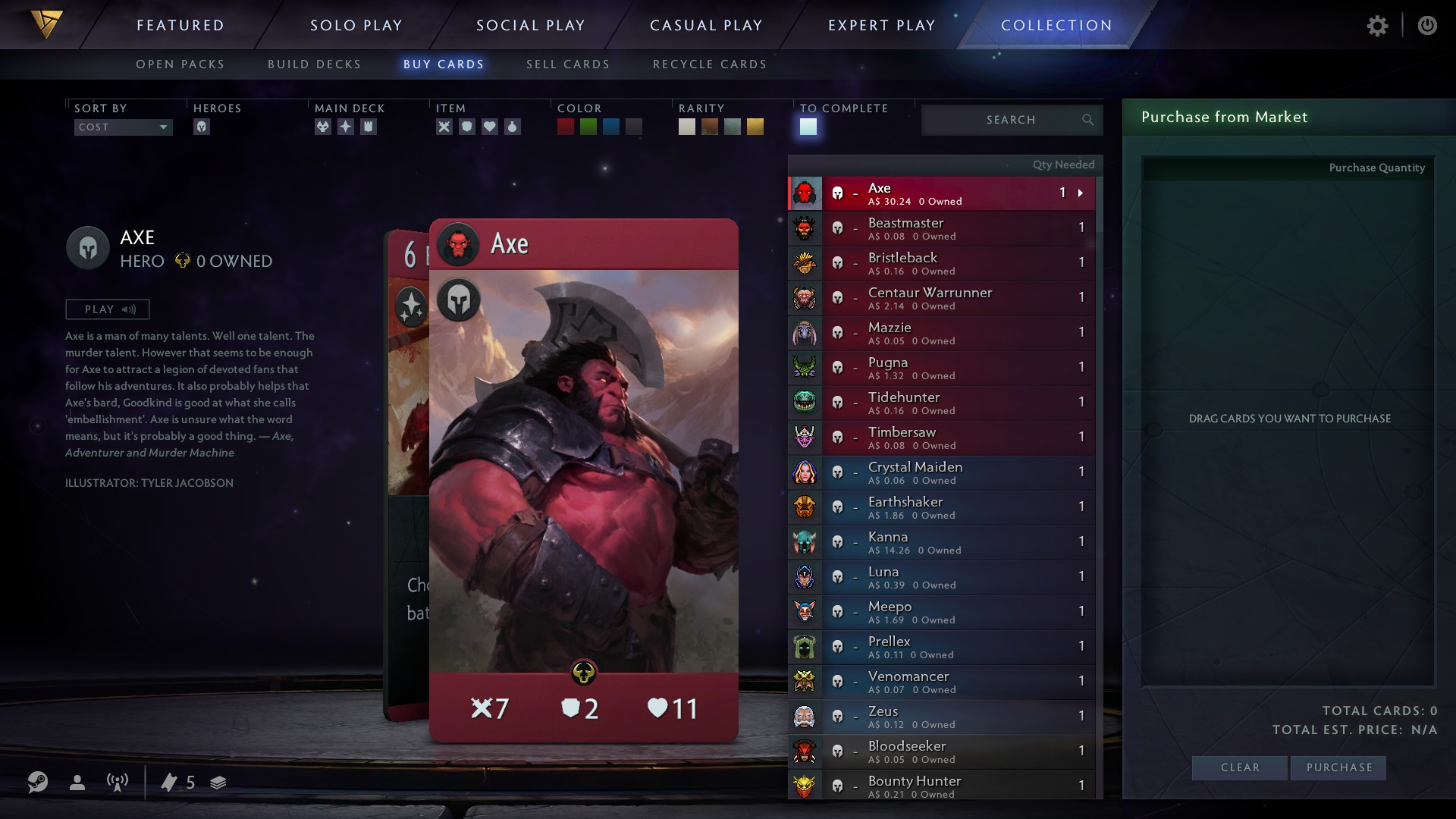
Given that Hearthstone, MtG: Arena and Gwent all let you earn more cards as you play for free, it’s outright ridiculous that Artifact has you paying to play for more cards. The sentiment is one of ‘git gud or pay up’, which is a little insulting given that I’ve already paid $27.95. Of course, if you’re averse to the randomness of packs, you might want to buy the cards from the marketplace outright, but it’s a little chaotic out there.
Cards can be bought and sold from the Steam marketplace, though how much those cards go for is quite insane. Axe is currently sitting at $24, Drow Ranger at $17.73, Annihilation at $9.94, the list keeps going. The pay to win reality from physical cards like Magic: The Gathering is Artifact’s business model, and it ’s shit. It’s not even a physical good. Its rarity is a fiction. You can’t even buy decks for their juicy cards inside; you have to buy the packs or get the cards from the marketplace. Oh, sure, you can sell cards too, but most cards go for 7 cents a pop, so you’ll likely get all of 84 cents back. The worst part is that Valve gets a cut on each of these purchases, yet they couldn’t possibly afford to make the client free or have a way to earn cards in-game? No, couldn’t let players support the game through board skins or card backs, that’s outrageous. It’s just a ludicrous decision to apply the model of a physical card to digital ones.

If I were to run down to Tactics and buy a Magic deck right now, I’d own some flashy cardboard. With that cardboard, I can play a regular game of magic with a friend, apply some house rules for a bit of chaos or trade cards with another buddy. In Artifact, I can’t buy a deck, I can’t play house rules, I can’t trade with friends and I can’t do anything outside the prescribed ruleset of how I’m allowed to use these cards. There’s no social element here whatsoever, even with a dedicated menu item in-game for playing with friends. We have to buy cards individually, and we can’t borrow each other’s decks or switch cards around, which is ludicrous given how much Valve wants for them. It’s not an issue in Hearthstone or Gwent because they’re free, and I can disenchant excess cards to make new ones in Hearthstone. It boggles the mind that Artifact is trying to be a trading card game without any idea of what trading cards entail, and it’s seriously ruining the discourse surrounding the game.
You know when guides are being made about what cards to buy rather than what strats are heckin’ rad, the game is suffering a serious problem. The monetisation is ruining an otherwise great (arguably) game, so much so that people need to know how to remain competitive on a budget. After all, if the aim is to get more cards, how can we do it without spending $60 for a deck? It’s great that you have the option of buying specific cards, but it’s become more of a talking point than the game itself. We’re getting so caught up in buying and selling the cards that the game is almost a tertiary concern, and that’s not a great sign. Paying to get the best cards is a problem I didn’t want to bring over from physical card games, and yet, somehow, Valve made it even worse. You can’t just pay to win anymore, because you’re going to have to pay to play.

Take caution before letting Artifact consume you. The monetisation is an egregious disaster, the RNG practically runs the game sometimes, and casual players will have no reason to keep coming back. There’s some fun in there; it’s just locked behind statistically improbable gauntlets and marketplace auctions. Worth the asking price? I’d lean towards no. Worth the investment required? Absolutely not. The buy-in isn’t enough to sustain your time with the game, and it’s almost insulting that there’s no way to earn cards when Valve already takes a cut from marketplace sales. The cards must flow, and thy wallet is tribute.











